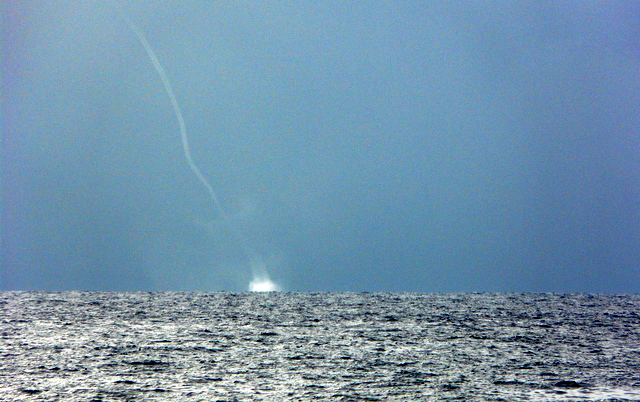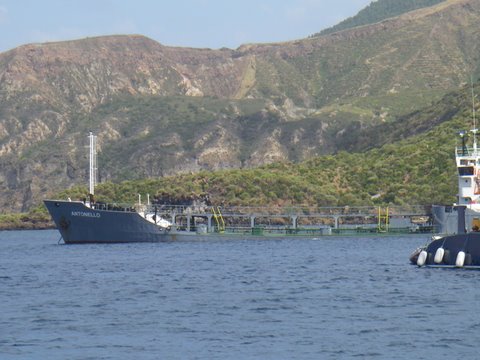Cruising the Aeolian islands

|
While we were still at anchor at Vulcano, as the strength of the wind was
abating and the barometer was gradually rising, the port area which is use by
the ferries, of various descriptions, still had numerous sailing boats at
anchor. The wind had reduced to gusting force 6 rather than the earlier force 8
and the sea, though not smooth was less choppy.
As mentioned in my previous blog, the presence of so many boats at anchor in the port, impeded the business of a larger ferry boat, although the smaller ferries were still able to continue to ply their trade, the larger boat was unable to enter the harbour and had to turn around and continue on the next part of its passage. Mid afternoon, a tanker arrived, it was so heavily laden that the deck was hardly above the level of the water. As it approached the harbour, it sounder its horn and a man in a dinghy took a long line ashore. Several sailing boats raised their anchor and left the port. Then the dinghy helped to guide the tanker to a berth, off the end of the breakwater. The tanker dropped an anchor and the dinghy took another long line ashore and made the ship secure. While this was happening, the ferryboat arrived, which earlier in the day had been unable to gain access to the port. As there were now fewer sailing boats at anchor, this time the ferry managed to reach its berth, the passengers and vehicles disembarked and it was once again, on its way. Some of the ferries, rather than enter the harbour, tend to use the berth at the end of the breakwater. With the tanker there, these ferries, despite their manoevreability, had considerable difficulty gaining access and had to do so, from what appeared to be, very awkward angles. The wind dropped to mainly force 4 by 10pm when suddenly, we were hit by a squall and for 10 or 15 minutes the rain fell and the wind again gusted at force 8. It had settled back to force 5 when we went to bed. Next morning, the water tanker, having discharged its cargo, had gone. A beautiful blue, Italian registered, custom built, 60+ foot schooner with teak decks, arrived mid morning with one person on the helm and another dealing with the anchor. It was all done quietly and without trauma. We have become used to seeing so many boats, inundated with people, often without a clue, it makes quite a change to see just 2 people on board and doing a good job. On Tuesday, light wind and
isolated thunder storms were forecast so late morning, we lifted the anchor and
made passage to the We joined the 4 other Lagoons, three being 440’s, in Cala Zimmari on the south of the island, along with eleven monohulls. Late afternoon, we saw a water spout, just outside the bay. Dick rushed for his camera and by the time he was able to take a photograph, I am pleased to say that it was moving away. The thunder storms were not isolated they were continuous, all throughout the night and the following morning. During the night, the wind was gusting 24knots, from all directions except east, up to31knots during the morning. It was unsurprising that we, as well as most of the other boats at anchor, had to re-anchor during the night. The pilot book did state that there are no really secure anchorages around these volcanic islands. We also re-anchored as soon as it became light, to what appeared to be a more advantageous position on the edge of the bay. Unfortunately, during the night, while one of the monohulls was attempting to raise its anchor after it had dragged. Although illuminated, the float was detached from our anchor by the force of the other boat’s propeller. We are much relieved that our anchor wasn’t fouled during the process. Although the thunderstorms finally cleared by lunchtime we spent another night at this anchorage. Quite close to our anchorage, a village dating from 1500BC, has been excavated. An underwater excavation has also been started on a ship, dating from around 400BC. Apparently, the excavation is hindered by the fact that the volcanic gas, interacting with the warm water produces sulphuric acid, making it a difficult environment for exploration. Next morning, with the sun
shining and light winds, we sailed to the volcanic
We sailed all around the island, fumaroles constantly feeding the cloud above. There was evidence of lava flow on all sides. The main flow was down the west side. It seemed incredible that there were so many houses on the island, particularly on the southern side, which appeared to have no roads out of the community. .The recommended anchorages at
Another beautiful morning and we are off to Lipari, the largest island of the archipelago, where we anchor in 20metres. These islands were settled from as early as 3000BC and prospered until the Bronze Age, by trading initially in the obsidian found here. Vulcano didn’t even appear from the sea until 183BC. In Lapari town and nearby, numerous ruins and historical relics, have been excavated, an amazing display of which are exhibited at the museum.
|

